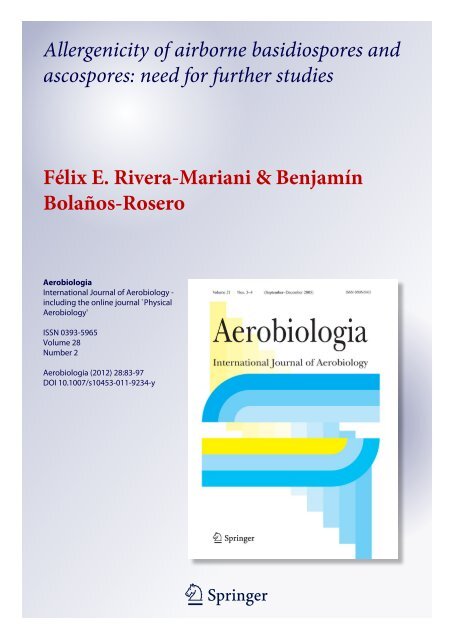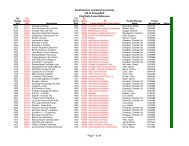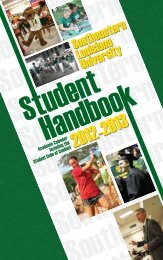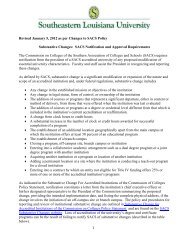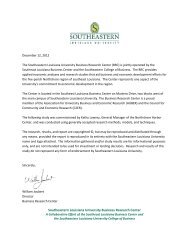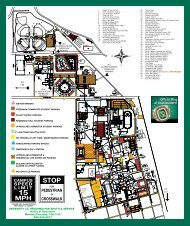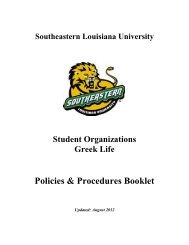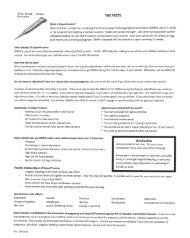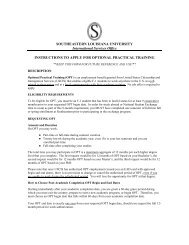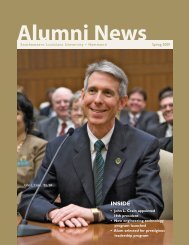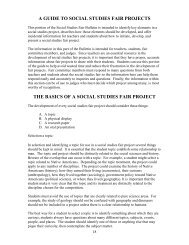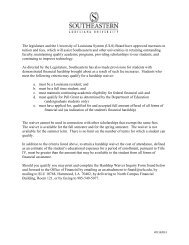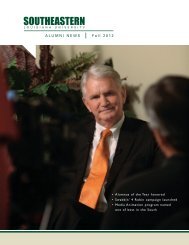Allergenicity of airborne basidiospores and ascospores: need for ...
Allergenicity of airborne basidiospores and ascospores: need for ...
Allergenicity of airborne basidiospores and ascospores: need for ...
Create successful ePaper yourself
Turn your PDF publications into a flip-book with our unique Google optimized e-Paper software.
<strong>Allergenicity</strong> <strong>of</strong> <strong>airborne</strong> <strong>basidiospores</strong> <strong>and</strong><br />
<strong>ascospores</strong>: <strong>need</strong> <strong>for</strong> further studies<br />
Félix E. Rivera-Mariani & Benjamín<br />
Bolaños-Rosero<br />
Aerobiologia<br />
International Journal <strong>of</strong> Aerobiology -<br />
including the online journal `Physical<br />
Aerobiology'<br />
ISSN 0393-5965<br />
Volume 28<br />
Number 2<br />
Aerobiologia (2012) 28:83-97<br />
DOI 10.1007/s10453-011-9234-y<br />
1 23
Your article is protected by copyright <strong>and</strong><br />
all rights are held exclusively by Springer<br />
Science+Business Media B.V.. This e-<strong>of</strong>fprint<br />
is <strong>for</strong> personal use only <strong>and</strong> shall not be selfarchived<br />
in electronic repositories. If you<br />
wish to self-archive your work, please use the<br />
accepted author’s version <strong>for</strong> posting to your<br />
own website or your institution’s repository.<br />
You may further deposit the accepted author’s<br />
version on a funder’s repository at a funder’s<br />
request, provided it is not made publicly<br />
available until 12 months after publication.<br />
1 23
Author's personal copy<br />
Aerobiologia (2012) 28:83–97<br />
DOI 10.1007/s10453-011-9234-y<br />
REVIEW PAPER<br />
<strong>Allergenicity</strong> <strong>of</strong> <strong>airborne</strong> <strong>basidiospores</strong> <strong>and</strong> <strong>ascospores</strong>:<br />
<strong>need</strong> <strong>for</strong> further studies<br />
Félix E. Rivera-Mariani •<br />
Benjamín Bolaños-Rosero<br />
Received: 26 March 2011 / Accepted: 27 September 2011 / Published online: 25 October 2011<br />
Ó Springer Science+Business Media B.V. 2011<br />
Abstract Many known fungal species are grouped<br />
among basidiomycetes <strong>and</strong> ascomycetes. Active<br />
mechanisms <strong>of</strong> spore release into air currents are<br />
among the main features <strong>of</strong> these fungi. Aerobiological<br />
studies have described their presence in many<br />
regions worldwide. In some areas, fungi have been<br />
described as the predominant outdoor <strong>airborne</strong> biological<br />
particulate with much higher concentrations<br />
than pollen. Other studies have determined that among<br />
the fungal aerospora, the highest concentrations<br />
belong to <strong>basidiospores</strong> <strong>and</strong> <strong>ascospores</strong>. Nevertheless,<br />
the allergenic potential <strong>of</strong> spores from basidiomycetes<br />
<strong>and</strong> meiotic <strong>for</strong>ms <strong>of</strong> ascomycetes has not been studied<br />
to the extent <strong>of</strong> mitosporic fungi <strong>and</strong> allergens from<br />
other sources. The <strong>need</strong> to further evaluate the role <strong>of</strong><br />
basidiomycetes <strong>and</strong> meiotic ascomycetes in allergies<br />
is evidenced by the few genera with characterized<br />
allergens <strong>and</strong> limited studies that had demonstrated<br />
Félix E. Rivera-Mariani <strong>and</strong> Benjamín Bolaños-Rosero<br />
contributed equally to this work.<br />
F. E. Rivera-Mariani (&)<br />
Department <strong>of</strong> Environmental Health Sciences,<br />
Bloomberg School <strong>of</strong> Public Health, Johns Hopkins<br />
University, 615 N. Wolfe Street, E6628, Baltimore,<br />
MD 21205, USA<br />
e-mail: frivera2@jhmi.edu<br />
B. Bolaños-Rosero<br />
Department <strong>of</strong> Microbiology <strong>and</strong> Medical Zoology,<br />
University <strong>of</strong> Puerto Rico, Medical Sciences Campus,<br />
San Juan, PR 00935, USA<br />
levels <strong>of</strong> sensitization similar or higher to that <strong>of</strong><br />
mitosporic fungi <strong>and</strong> other allergens. In this review,<br />
based on the existing aerobiological, epidemiological,<br />
immunological, <strong>and</strong> molecular biology studies, we<br />
provide evidence that the role <strong>of</strong> basidiomycetes <strong>and</strong><br />
ascomycetes deserves more attention with respect to<br />
their roles as potential aeroallergens.<br />
Keywords Allergen Airborne Basidiomycete <br />
Ascomycetes Basidiospore Ascospore<br />
Abbreviations<br />
AR Allergic rhinitis<br />
Asco Ascospores<br />
AS Asthma<br />
Basid Basidiospores<br />
Deutero Deuteromycetes/mitosporic fungi<br />
H/F Hyphae <strong>and</strong> fragments<br />
IgE Immunoglobulin E<br />
NAR Nonallergic rhinitis<br />
unID Particles not able to be identified<br />
WHO/IUIS World Health Organization <strong>and</strong><br />
International Union <strong>of</strong> Immunological<br />
Societies Allergen Nomenclature<br />
Sub-committee<br />
1 Introduction<br />
The fungal kingdom is composed <strong>of</strong> members usually<br />
known <strong>for</strong> their ability to degrade organic nonliving or<br />
123
Author's personal copy<br />
84 Aerobiologia (2012) 28:83–97<br />
dead material (Alexopoulos et al. 1996; Stephenson<br />
2010). The vast majority share features with plants,<br />
such as being eukaryotic, having cell wall, absorptive<br />
nutrition, <strong>and</strong> some reproduce sexually <strong>and</strong> others<br />
asexually. Contrary to plants, they do not produce<br />
sugars through photosynthesis <strong>and</strong> their dispersal<br />
structures (spores or conidia) <strong>and</strong> absorptive filaments<br />
(hyphae or mycelia) are much smaller than those <strong>of</strong><br />
plants (Alexopoulos et al. 1996; Stephenson 2010). In<br />
addition, many fungi have structural components<br />
found in the exoskeleton <strong>of</strong> insects <strong>and</strong> arthropods,<br />
such as chitin (polymer <strong>of</strong> N-acetylglucosamine) <strong>and</strong><br />
b-glucans (polymer <strong>of</strong> glucose), which are important<br />
structural components fungal cell walls (Stephenson<br />
2010). With respect to diseases, fungi also share one<br />
important feature with animals <strong>and</strong> plants: the<br />
potential to induce allergies.<br />
Basidiomycetes (phylum Basidiomycota) <strong>and</strong> ascomycetes<br />
(phylum Ascomycota) are two important<br />
groups within the fungi kingdom. They are widespread<br />
in different environments throughout the world, <strong>and</strong> a<br />
variety <strong>of</strong> species can be present depending on the<br />
characteristic climate <strong>of</strong> a particular region or season<br />
(Horn et al. 1993; Alexopoulos et al. 1996; Stamets<br />
2002). They play different <strong>and</strong> important roles in<br />
many ecosystems, such as degrading organic matter<br />
<strong>and</strong> facilitating the absorption <strong>of</strong> nutrients, <strong>and</strong> some<br />
are <strong>of</strong>ten found parasitizing other organisms (Alexopoulos<br />
et al. 1996). In addition, there are species that<br />
are commercially distributed (e.g., gilled mushroom<br />
Pleurotus ostreatus), many are poisonous (e.g., gilled<br />
mushrooms Chlorophyllum molybdites <strong>and</strong> Amanita<br />
muscaria, etc.), <strong>and</strong> others are rarely noticeable in<br />
their ecosystems (Horn et al. 1993; Alexopoulos et al.<br />
1996; Stamets 2002).<br />
The structures responsible <strong>for</strong> the dispersal <strong>of</strong> fungi<br />
(spores) are present in the atmosphere <strong>of</strong> many areas.<br />
Numerous studies have described their presence in air,<br />
but most <strong>of</strong> these investigations have been per<strong>for</strong>med<br />
in temperate regions (Table 1) (D’Amato <strong>and</strong><br />
Spieksma 1995; Horn et al. 1995; Burge <strong>and</strong> Rogers<br />
2000; Troutt <strong>and</strong> Levetin 2001; Burch <strong>and</strong> Levetin<br />
2002; Burge 2002; Levetin <strong>and</strong> Horner 2002; Agashe<br />
<strong>and</strong> Caulton 2009; Quintero et al. 2010). Basidiospores<br />
<strong>and</strong> <strong>ascospores</strong> are among the predominant <strong>airborne</strong><br />
biological particles in these studies. For these reasons<br />
<strong>and</strong> the small size <strong>of</strong> many <strong>ascospores</strong> <strong>and</strong> <strong>basidiospores</strong><br />
that allows them to reach deep into the respiratory<br />
tract (Horn et al. 1995; Levetin <strong>and</strong> Horner 2002; Horn<br />
Table 1 Aerobiological studies in which <strong>basidiospores</strong> <strong>and</strong><br />
<strong>ascospores</strong> were found to be predominant in the atmosphere<br />
Author (year published)<br />
Jenkins et al. (1980)<br />
Levetin (1990)<br />
Comtois <strong>and</strong> M<strong>and</strong>rioli (1996)<br />
Delfino et al. (1997)<br />
Sterling et al. (1999)<br />
Agashe <strong>and</strong> Vidya (1999)<br />
Craig <strong>and</strong> Levetin (2000)<br />
Dales et al. (2000)<br />
Troutt <strong>and</strong> Levetin (2001)<br />
Chakraborty et al. (2001)<br />
Mitakakis et al. (2001)<br />
Hasnain et al. (2005)<br />
Morales et al. (2006)<br />
Green et al. (2006a, b, c)<br />
De Antoni Zoppas et al. (2006)<br />
Bianchi <strong>and</strong> Olabuenaga (2006)<br />
Herrero et al. (2006)<br />
Pyrri <strong>and</strong> Kapsanaki-Gotsi (2007)<br />
Grinn-G<strong>of</strong>roń <strong>and</strong> Mika (2008)<br />
Khattab <strong>and</strong> Levetin (2008)<br />
Quintero et al. (2010)<br />
Location<br />
UK<br />
USA (Midwest)<br />
Middle East (Adriatic Sea)<br />
USA (West)<br />
USA (Midwest)<br />
India<br />
USA (Midwest)<br />
Canada<br />
USA (Midwest)<br />
India<br />
Australia<br />
Saudi Arabia<br />
Spain<br />
Australia<br />
Brazil<br />
Argentina<br />
Spain<br />
Greece<br />
Pol<strong>and</strong><br />
USA (Midwest)<br />
Puerto Rico<br />
et al. 2004), their potential to cause exacerbations <strong>of</strong><br />
respiratory diseases should not be disregarded.<br />
The allergenicity <strong>of</strong> fungi has been recognized, but<br />
their allergens have not been studied as those from<br />
other sources such as animal, plants, food, among<br />
others. Although there are studies that have described<br />
the presence <strong>of</strong> sensitivity to basidiomycetes <strong>and</strong><br />
ascomycetes among subjects with respiratory allergies<br />
(Sprenger et al. 1988; Horner et al. 1992; Lehre et al.<br />
1994; Helbling et al. 2002), there is limited literature<br />
about their allergens compared to that <strong>of</strong> mitosporic<br />
fungi (spores produced asexually), such as Alternaria<br />
spp., Penicillium spp., <strong>and</strong> Aspergillus spp. It is<br />
surprising that basidiomycetes <strong>and</strong> ascomycetes have<br />
not been more widely investigated given their<br />
potential allergenecity, <strong>and</strong> that their widespread<br />
distribution <strong>and</strong> ability to release numerous spores<br />
makes them a potential important contributor to the<br />
biological component <strong>of</strong> particulate matter (Hyde<br />
1972).<br />
The purpose <strong>of</strong> this review is to describe the<br />
importance <strong>of</strong> <strong>basidiospores</strong> <strong>and</strong> <strong>ascospores</strong> as<br />
123
Author's personal copy<br />
Aerobiologia (2012) 28:83–97 85<br />
allergens based on the current aerobiological, epidemiological,<br />
<strong>and</strong> immunological studies that have been<br />
per<strong>for</strong>med in different regions worldwide. In addition,<br />
evidence will be provided to support the <strong>need</strong> <strong>for</strong> more<br />
studies to better define the role <strong>of</strong> basidiomycetes <strong>and</strong><br />
ascomycetes in allergic respiratory diseases.<br />
2 Mycology <strong>of</strong> basidiomycetes <strong>and</strong> ascomycetes<br />
The phylum Basidiomycota is composed <strong>of</strong> a large <strong>and</strong><br />
diverse group (approximately 30,000 species) <strong>of</strong> fungi<br />
that includes puffballs, mushrooms, boletes, earthstars,<br />
stinkhorns, bird’s nest, jelly fungi, bracket, rusts,<br />
<strong>and</strong> smuts (Fig. 1) (Ingold <strong>and</strong> Hudson 1993; Alexopoulos<br />
et al. 1996). They can be found in a wide range<br />
<strong>of</strong> substrates (e.g., on trees <strong>and</strong> <strong>for</strong>est litter, grass<br />
l<strong>and</strong>s, <strong>and</strong> wood products) degrading cellulose <strong>and</strong><br />
lignin, processes important <strong>for</strong> the organic cycle.<br />
Others are parasites <strong>of</strong> various crops (e.g., smuts <strong>and</strong><br />
ruts) or contribute to the life cycle <strong>of</strong> higher plants<br />
(Horn et al. 1993; Alexopoulos et al. 1996; Morales<br />
2006). In addition, many have been used <strong>for</strong> centuries<br />
<strong>for</strong> natural medicine purposes in many regions, such as<br />
in East Asian societies (Stamets 2002).<br />
In contrast with mitosporic fungi (Fungi Imperfecti<br />
<strong>and</strong> <strong>for</strong>merly known as deuteromycetes) which produce<br />
spores by mitotic division, basidiomycetes are<br />
meiosporic (spores result from meiosis) fungi that<br />
produce haploid sexual spores, or <strong>basidiospores</strong>,<br />
usually in groups <strong>of</strong> four on a specialized structure<br />
known as a basidium (basidia in plural; Fig. 2a)<br />
(Alexopoulos et al. 1996; Morales et al. 2006).<br />
Furthermore, while mitospores (spores from mitotic<br />
Fig. 1 Examples <strong>of</strong> some<br />
basidiomycetes. a Gilled<br />
mushroom (Mycena spp);<br />
b jelly fungi (Auricularia<br />
auricular); c polypore<br />
(Ganoderma applanatum);<br />
d earthstar (Geastrum<br />
triplex); e boletes (Boletus<br />
roseopurpureus); f puffball<br />
(Morganella fuliginea);<br />
g stinkhorn (Dictyophora<br />
indusiata). Notice the spore<br />
deposits on the leaves under<br />
the fruiting body <strong>of</strong> G.<br />
applanatum, which releases<br />
trillions <strong>of</strong> spores daily.<br />
Images D through G are<br />
courtesy <strong>of</strong> Dr. Deborah J.<br />
Lodge<br />
123
Author's personal copy<br />
86 Aerobiologia (2012) 28:83–97<br />
Fig. 2 Mechanisms <strong>of</strong> spore release <strong>for</strong> <strong>basidiospores</strong> <strong>and</strong><br />
<strong>ascospores</strong>. Humidity nearby the canopy <strong>of</strong> the fruiting body<br />
leads to the accumulation <strong>of</strong> water on the basidiospore-bearing<br />
structures in basidiomycetes (a). As the water droplet, or<br />
Buller’s drop, begins to grow the gravitational center <strong>of</strong> the<br />
spore is shifted. Once the Buller’s drop reaches the end <strong>of</strong> the<br />
spore where it is attached to the sterigmata, the sudden<br />
movement <strong>of</strong> the spores caused by the Buller’s drop leads to<br />
its release from its point <strong>of</strong> attachment (b, C). With ascomycetes,<br />
in normal conditions there are usually 8 <strong>ascospores</strong> inside the<br />
ascus (d). Once humidity increases in the environment where the<br />
ascomycetes are found, an increase in osmotic pressure (dashed<br />
red arrows) begins to accumulate inside the ascus. The osmotic<br />
pressure keeps rising <strong>and</strong> cluttering the <strong>ascospores</strong> at the top <strong>of</strong><br />
the ascus until they are eventually ejected (e). b, c correspond to<br />
reference Pringle et al. 2005; d from Phillips et al. 2005; e from<br />
Trail et al. 2002. Reprinted with permission from Mycologia Ó<br />
The Mycologial Society <strong>of</strong> America<br />
fungi) are released by a passive mechanism or external<br />
<strong>for</strong>ce (e.g., nearby wind currents) <strong>for</strong> dispersal from<br />
their spore-bearing structures, <strong>basidiospores</strong> are<br />
released by an active mechanisms associated with<br />
humidity <strong>and</strong> the Buller’s drop that affects the<br />
gravitational center <strong>of</strong> the spore causing it to be<br />
catapulted <strong>and</strong> released (Fig. 2b, c) (Pringle et al.<br />
2005). This is one <strong>of</strong> the reasons why after a rain event,<br />
when relative humidity increases, high concentrations<br />
<strong>of</strong> <strong>basidiospores</strong> in the atmosphere are <strong>of</strong>ten recorded<br />
(Fig. 3) (Levetin 1990; Isard <strong>and</strong> Gage 2001; Quintero<br />
et al. 2010).<br />
Members <strong>of</strong> the phylum Ascomycota, constituted<br />
with nearly 25,000 members, share many characteristics<br />
with that <strong>of</strong> basidiomycetes with respect to<br />
habitats, functions in nature, meiotic division <strong>for</strong> spore<br />
production, <strong>and</strong> an active mechanisms <strong>for</strong> the release<br />
<strong>of</strong> the spores (Kendrick 1992; Ingold <strong>and</strong> Hudson<br />
1993; Alexopoulos et al. 1996; Blackwell et al. 2006).<br />
As the name implies, the sexual spores (<strong>ascospores</strong>) <strong>of</strong><br />
this group are in an ascus (asci in plural; Fig. 2d,e)<br />
usually in groups <strong>of</strong> eight <strong>and</strong> released when the<br />
osmotic pressure inside the ascus increases although<br />
other physical elements, depending on the genera, are<br />
also involved (Stensv<strong>and</strong> et al. 1997; Trail et al. 2002;<br />
Clarkson et al. 2003; van Heerden et al. 2005). It is<br />
important to clarify that within this phylum mitosporic<br />
fungi are classified (e.g., Cladosporium, Fusarium,<br />
Alternaria, etc.), but their spores, as mentioned be<strong>for</strong>e,<br />
are a result <strong>of</strong> mitosis. Mitosporic fungi are the asexual<br />
123
Author's personal copy<br />
Aerobiologia (2012) 28:83–97 87<br />
Fig. 3 Relationship<br />
between precipitation <strong>and</strong><br />
total concentrations <strong>of</strong><br />
spores in the atmosphere.<br />
Quintero et al. (6). Reprinted<br />
with permission from the<br />
publisher Springerlink<br />
stage <strong>of</strong> ascomycetes (Blackwell et al. 2006) <strong>and</strong> are<br />
no longer grouped as a single group; however, they<br />
will not be discussed because the focus <strong>of</strong> this review<br />
are the sexual (meiotic) <strong>for</strong>ms <strong>of</strong> ascomycetes.<br />
3 Aerobiology <strong>of</strong> <strong>basidiospores</strong> <strong>and</strong> <strong>ascospores</strong><br />
Although the term aerobiology has had different<br />
definitions, it mainly involves the study <strong>of</strong> the particles<br />
<strong>of</strong> biological origin present in the atmosphere <strong>and</strong> the<br />
factors that directly or indirectly affect their source,<br />
liberation, transport, dispersal, deposition, <strong>and</strong> impact<br />
(Isard <strong>and</strong> Gage 2001; Burge 2002; Agashe <strong>and</strong><br />
Caulton 2009). As a result, there have been numerous<br />
studies, at different locations around the globe, to<br />
determine the predominant outdoor <strong>airborne</strong> biological<br />
particles.<br />
Fungal spores are a component <strong>of</strong> the atmosphere <strong>and</strong><br />
in many studies in temperate <strong>and</strong> a few tropical<br />
environments they have been found to be the most<br />
predominant biological particulate (Gregory 1961;<br />
Kendrick 1992; D’Amato <strong>and</strong> Spieksma 1995; Horner<br />
et al. 1995;Burge2002; Okten et al. 2005; Agashe <strong>and</strong><br />
Caulton 2009; Quinteroetal.2010). Their patterns<br />
<strong>of</strong> prevalence are governed by multiple factors, including<br />
plants floristic patterns, agricultural practices,<br />
meteorological variables, amount <strong>of</strong> organic litter, <strong>and</strong><br />
presence <strong>and</strong> age <strong>of</strong> colony <strong>and</strong>/or fruiting body, among<br />
others (Kendrick 1992; Alexopoulos et al. 1996;Horner<br />
et al. 1998; Burge <strong>and</strong> Rogers 2000;Magyar2002; Ceter<br />
<strong>and</strong> Pinar 2009; Quintero et al. 2010). For example, in<br />
temperate regions, such as in the United States <strong>and</strong><br />
Europe, spores appear in late winter becoming more<br />
prevalent in summer <strong>and</strong> fall. In the tropics, they seem to<br />
be prevalent throughout the year with the rainy season<br />
(Spring <strong>and</strong> Fall) showing the highest concentrations<br />
(D’Amato <strong>and</strong> Spieksma 1995; Bush <strong>and</strong> Portnoy 2001;<br />
Burton <strong>and</strong> Katelaris 2010; Quintero et al. 2010). There<br />
are also differences in the predominant fungi, with<br />
mitosporic fungi (e.g., Alternaria sp., Cladosporium sp.,<br />
Aspergillus/Penicillium) being more prevalent in temperate<br />
regions, but <strong>basidiospores</strong> <strong>and</strong> <strong>ascospores</strong> predominating<br />
in tropical areas (Hasnain et al. 2005; Ceter<br />
<strong>and</strong> Pinar 2009; Burton <strong>and</strong> Katelaris 2010; Quintero<br />
et al. 2010).<br />
3.1 Aerodynamic <strong>and</strong> atmospheric factors<br />
Various combinations <strong>of</strong> atmospheric factors <strong>and</strong><br />
innate characteristics <strong>of</strong> fungal species have different<br />
effects on the trajectory <strong>of</strong> air fungal spora. Wind<br />
speed <strong>and</strong> direction, temperature, humidity, rain,<br />
among others atmospheric variables have been<br />
123
Author's personal copy<br />
88 Aerobiologia (2012) 28:83–97<br />
extensively studied in different parts <strong>of</strong> the world <strong>and</strong><br />
in different settings (i.e., urban <strong>and</strong> rural areas) with<br />
respect to their effects on concentration <strong>and</strong> dispersal<br />
<strong>of</strong> bioaerosols, including fungal spores (Hurtado et al.<br />
1989; Nagarajan <strong>and</strong> Singh 1990; Madelin <strong>and</strong><br />
Johnson 1992; Tan et al. 1992; Spieksma 1993;<br />
D’Amato <strong>and</strong> Spieksma 1995; Lewisn et al. 2000;<br />
Chakraborty et al. 2001; Levetin <strong>and</strong> Van de Water<br />
2001; Troutt <strong>and</strong> Levetin 2001; Burch <strong>and</strong> Levetin<br />
2002; Magyar 2002; Sakiyan <strong>and</strong> Inceoglu 2003;<br />
Horner et al. 2004; Newhouse <strong>and</strong> Levetin 2004;<br />
Rodriguez-Rajo et al. 2004; Burton <strong>and</strong> Katelaris<br />
2010; Quinteroi et al. 2010). These investigations have<br />
also described the different mechanisms <strong>of</strong> spore<br />
liberation, concentrations <strong>of</strong> spores released per day,<br />
<strong>and</strong> the environmental conditions that influence the<br />
liberation <strong>and</strong> dispersal <strong>of</strong> spores from different fungi.<br />
Taken together, these studies have contributed important<br />
aerobiological in<strong>for</strong>mation about spores, but there<br />
is a consensus that more studies are <strong>need</strong>ed (Horner<br />
et al. 2004; Newhouse <strong>and</strong> Levetin 2004; et al.<br />
Morales et al. 2006; Agashe <strong>and</strong> Caulton 2009; Ceter<br />
<strong>and</strong> Pinar 2009; Quintero et al. 2010).<br />
Among all atmospheric variables studied, wind is<br />
the most important <strong>for</strong> the dispersal <strong>of</strong> spores (Alexopoulos<br />
et al. 1996). Mitosporic fungi are fully<br />
dependent on the wind because their mechanism <strong>of</strong><br />
spore release is passive <strong>and</strong> the air current moving<br />
nearby the spore-bearing structures is the <strong>for</strong>ce that<br />
liberates them (Alexopoulos et al. 1996). On the other<br />
h<strong>and</strong>, as mentioned previously, basidiomycetes <strong>and</strong><br />
ascomycetes liberate their spores by mechanisms<br />
governed by the action <strong>of</strong> water (i.e., humidity <strong>and</strong><br />
dew point) on the basidium or ascus. The phototropic<br />
<strong>and</strong> geotropic properties <strong>of</strong> these fungi contribute to<br />
their orientation toward the light <strong>and</strong> away from the<br />
grown, respectively. For agarics (spore-bearing structures<br />
within gills; Fig. 1a) <strong>and</strong> polypores (sporebearing<br />
structures within pores; Fig. 1b), this allows<br />
the downward exit <strong>of</strong> the spores from the fruiting<br />
bodies, while other fungi such as those <strong>of</strong> puffballs<br />
(spore-bearing structures inside a ball-shape fruiting<br />
body; Fig. 1f) <strong>need</strong> to be oriented toward the light in<br />
order to release their spores once a rain drop impacts<br />
their surface. In this manner, the spores are easily<br />
accessible to turbulent currents flowing nearby the<br />
fruiting body (Isard <strong>and</strong> Gage 2001). Once <strong>airborne</strong>,<br />
other large-scale air movements, such as convection<br />
currents, low-level jets, global wind belts, <strong>and</strong> tropical<br />
<strong>and</strong> extratropical cyclones <strong>and</strong> anticyclones, can<br />
transport spores in patches, within <strong>and</strong> between<br />
l<strong>and</strong>scapes, eco-regions, or between continents,<br />
respectively (Nagarajan <strong>and</strong> Singh 1990; Levizzani<br />
et al. 1998; Isard <strong>and</strong> Gage 2001).<br />
The temperature <strong>of</strong> the air also plays a role in the<br />
movement <strong>of</strong> air spora but, contrary to air currents, its<br />
effect is mainly at ground level (i.e., enclosed place,<br />
within vegetation). When the temperature <strong>of</strong> the<br />
surrounding air or ground increases, a convection<br />
current moves the suspended particulate upwards; the<br />
opposite occurs when the air cools down, together<br />
creating a vertical dispersion gradient (Agashe <strong>and</strong><br />
Caulton 2009). These events take place mainly in<br />
<strong>for</strong>ests or where there are numerous fruiting bodies,<br />
but once they encounter turbulent air currents, the<br />
convection currents no longer contribute to transport<br />
within the atmosphere.<br />
Water can also contribute to the concentration <strong>of</strong><br />
spores in the atmosphere. Rain events <strong>of</strong> high intensity<br />
could clean the atmosphere by <strong>for</strong>cing down suspended<br />
spores, while small amount <strong>of</strong> rain can work at<br />
the leaf or fruiting body level by provoking the<br />
movement <strong>of</strong> fungal spores from the leaf surface with<br />
splashes or inducing the ejection <strong>of</strong> spores, respectively<br />
(Burge <strong>and</strong> Rogers 2000; Chakraborty et al.<br />
2001; Levetin <strong>and</strong> Horner 2002). This mechanism is<br />
seen with dry spores that are <strong>of</strong>ten found parasitizing<br />
leaves, such as many <strong>of</strong> the mitosporic fungi (e.g.,<br />
Cladosporium spp, Alternaria spp., etc.). As previously<br />
described, water that accumulates on the surface<br />
<strong>of</strong> fruiting bodies induces the liberation <strong>of</strong> spores from<br />
basidiomycetes by the action <strong>of</strong> the Buller’s drop<br />
(Fig. 2b, c) on the gravitational center <strong>of</strong> the <strong>basidiospores</strong><br />
or the increase in osmotic pressure inside the<br />
ascus <strong>for</strong>cing the ejection <strong>of</strong> spores in ascomycetes<br />
(Fig. 2e).<br />
Basidiomycetes <strong>and</strong> ascomycetes are known to<br />
liberate numerous spores daily. This is one <strong>of</strong> the most<br />
important characteristics <strong>of</strong> these fungi <strong>and</strong> one <strong>of</strong> the<br />
reasons why, in few studies, they have been correlated<br />
with cases <strong>of</strong> chronic respiratory diseases, such as<br />
asthma <strong>and</strong> rhinitis (Bush <strong>and</strong> Portnoy 2001; Levetin<br />
<strong>and</strong> Van de Water 2001; Newhouse <strong>and</strong> Levetin 2004;<br />
Semik-Orzech et al. 2008). Plant pathogens, such as<br />
members <strong>of</strong> the genus Ganoderma spp. <strong>and</strong> Puccinia<br />
spp., are known to produce trillions <strong>and</strong> millions <strong>of</strong><br />
spores per square meter, respectively (Agashe <strong>and</strong><br />
Caulton 2009). Similarly, other studies have found<br />
123
Author's personal copy<br />
Aerobiologia (2012) 28:83–97 89<br />
<strong>ascospores</strong> in high concentrations throughout the year<br />
in different areas <strong>of</strong> the world (Stensv<strong>and</strong> et al. 1997;<br />
Magyar 2002; Ceter <strong>and</strong> Pinar 2009; Quintero et al.<br />
2010). Being widespread <strong>and</strong> the ability to liberate<br />
large concentrations <strong>of</strong> spores daily are two important<br />
aeroallergen characteristics (Hyde 1972; Gregory<br />
1973) common to many basidiomycetes <strong>and</strong> meiotic<br />
ascomycetes.<br />
4 Basidiospores <strong>and</strong> <strong>ascospores</strong> as allergens<br />
4.1 Respiratory allergies<br />
Respiratory allergies, allergic rhinitis, <strong>and</strong> asthma<br />
have been increasing worldwide (Braman 2006), <strong>and</strong><br />
numerous studies have described the importance <strong>of</strong><br />
<strong>airborne</strong> biogenic particulate matter in episodes <strong>of</strong><br />
these diseases, including those <strong>of</strong> fungal origin<br />
(Hiddlestone 1961; Lewis et al. 2000; Green et al.<br />
2003; Mari et al. 2003; Newhouse <strong>and</strong> Levetin 2004;<br />
Cho et al. 2005; Green et al. 2005a, b, c, 2006a, b, c;<br />
Semik-Orzech et al. 2008; Agashe <strong>and</strong> Caulton 2009).<br />
In addition, some investigations have found correlation<br />
between high concentrations <strong>of</strong> specific types <strong>of</strong><br />
spores with morbidity <strong>and</strong> mortality from asthma<br />
(Packe <strong>and</strong> Ayres 1985; Targonski et al. 1995; Delfino<br />
et al. 1997; Black et al. 2000; Chew et al. 2000; Lewis<br />
et al. 2000; Newhouse <strong>and</strong> Levetin 2004). Although<br />
mitosporic fungi <strong>and</strong> pollen seem to predominate in<br />
temperate regions, some aerobiological <strong>and</strong> epidemiological<br />
studies per<strong>for</strong>med in these areas have correlated<br />
asthma symptoms with concentrations <strong>of</strong><br />
<strong>basidiospores</strong> (Jenkins et al. 1980; Delfino et al.<br />
1996, 1997; Epton et al. 1997; Dales et al. 2000;<br />
Newhouse <strong>and</strong> Levetin 2004). In addition, some <strong>of</strong><br />
these studies have also found association <strong>of</strong> respiratory<br />
allergies with meteorological conditions that are<br />
suitable <strong>for</strong> the release <strong>of</strong> <strong>basidiospores</strong>, such as high<br />
humidity <strong>and</strong> dew point (Morrow-Brown <strong>and</strong> Jackson<br />
1985; Davidson et al. 1996; Lewis et al. 2000; Levetin<br />
<strong>and</strong> Van de Water 2001; Taylor <strong>and</strong> Jonsson 2004;<br />
Nasser <strong>and</strong> Pulimood 2009).<br />
There have been various reports that have correlated<br />
high concentrations <strong>of</strong> <strong>ascospores</strong> in various<br />
areas with respiratory conditions (Jenkins et al. 1980;<br />
Troutt <strong>and</strong> Levetin 2001; Magyar 2002; Ceter <strong>and</strong><br />
Pinar 2009). However, most <strong>of</strong> the epidemiological<br />
studies mentioned above have been per<strong>for</strong>med in<br />
temperate regions despite <strong>basidiospores</strong> <strong>and</strong> <strong>ascospores</strong><br />
being important component <strong>of</strong> the air spora in<br />
tropical areas. For this reason, the role <strong>of</strong> these fungal<br />
spores <strong>need</strong>s to be further studied emphasizing the<br />
tropics <strong>and</strong> their roles in cases <strong>of</strong> respiratory allergic<br />
diseases.<br />
4.2 Allergens<br />
Although the previous reports discussed mention<br />
<strong>basidiospores</strong> <strong>and</strong> <strong>ascospores</strong> being important components<br />
<strong>of</strong> the air spora, the vast majority <strong>of</strong> studies <strong>of</strong><br />
fungal allergens have been per<strong>for</strong>med in temperate<br />
areas where the testing <strong>for</strong> sensitization mainly relies<br />
on extracts from pollen <strong>and</strong> mitosporic fungi (Horner<br />
et al. 1995; Delfino et al. 1997; Chew et al. 2000;<br />
Green et al. 2003, 2005a, 2006a, b, 2009; Mari et al.<br />
2003; Denning et al. 2006; Semik-Orzech et al. 2008;<br />
Agashe <strong>and</strong> Caulton 2009). Extracts from these agents<br />
are commonly included in the panels <strong>for</strong> skin-prick<br />
tests <strong>and</strong> immunological assays <strong>for</strong> detecting allergies.<br />
According to the database <strong>of</strong> World Health Organization<br />
<strong>and</strong> International Union <strong>of</strong> Immunological Societies<br />
Allergen Nomenclature Sub-committee (WHO/<br />
IUIS http://www.allergen.org/index.php) (Table 2),<br />
the majority <strong>of</strong> allergenic proteins fully described<br />
from fungi correspond to mitosporic species such as<br />
Table 2 Comparison <strong>of</strong> total characterized allergens in animals,<br />
plants, <strong>and</strong> fungi<br />
Allergen source<br />
Animal 269<br />
Plants 322<br />
Fungi (Ascomycota) 79<br />
Capnodiales (e.g., Cladosporium spp.) 10<br />
Eurotiales (e.g., Aspergillus/Penicillium spp.) 45<br />
Hypocreales (e.g., Fusarium spp.) 2<br />
Onygenales (e.g., Trichophyton spp.) 4<br />
Pleosporales (e.g., Alternaria spp.) 15<br />
Saccharomycetales (e.g., C<strong>and</strong>ida spp.) 3<br />
Fungi (Basidiomycota) 22<br />
Agaricales (e.g., gilled musrooms) 7<br />
Malasseziales (e.g., Malassezia spp.) 13<br />
Sporidiobolales (e.g., Rhodotorula spp.) 2<br />
Characterized<br />
allergens<br />
Source World Health Organization Allergen <strong>and</strong> International<br />
Union <strong>of</strong> Immunological Societies Allergen Nomenclature<br />
Sub-committee: http://www.allergen.org<br />
123
Author's personal copy<br />
90 Aerobiologia (2012) 28:83–97<br />
Aspergillus spp, Penicillium spp, Fusarium spp,<br />
Alternaria spp, among others.<br />
Despite the lack <strong>of</strong> commercial extracts <strong>for</strong> basidiomycetes,<br />
there have been studies in which the<br />
presence <strong>for</strong> sensitization to basidiomycetes has been<br />
investigated in subjects with respiratory allergies<br />
(Table 3). Shichijo et al. (1970) tested <strong>for</strong> allergies<br />
with Cortinellus spp. A study by Santilli et al. (1985)<br />
with dialyzed extracts demonstrated reactivity in<br />
subjects with asthma or allergic rhinitis to Agaricus<br />
campestris, Coprinus micaceus, Fuligo septica, Lycoperdon<br />
perlatum, Scleroderma lycoperdoides, <strong>and</strong><br />
Ustilago maydi. In studies per<strong>for</strong>med by Lehrer et al.<br />
(1986, 1994), between 25 <strong>and</strong> 30% <strong>of</strong> the participants<br />
reacted to at least one basidiomycete extract. Helbling<br />
et al. (1993a, b, 1998, 1999) found skin-prick test<br />
reactivity, allergen-specific (immunoglobulin E) IgE,<br />
<strong>and</strong> responses in nasal challenges in subjects with<br />
respiratory allergies with spore or mycelial extracts<br />
from Psilocybe spp., Boletus spp, Coprinus spp, <strong>and</strong><br />
Pleurotus spp. Horner et al. (1988, 1989a, b, 1991,<br />
1993a, b; 1995) has also worked extensively with<br />
basidiospore <strong>and</strong> mycelial extracts, <strong>and</strong> even identified<br />
a protein from the mycelium <strong>of</strong> Psilocybe cubensis<br />
(Psi c 2, a cyclophilin) as one <strong>of</strong> the allergenic<br />
components. Other investigations have tested sensitization<br />
to other basidiomycetes, studied the most<br />
appropriate elution mechanisms from spores, mycelia,<br />
or other fruiting body’s tissues, demonstrated allergen-specific<br />
IgE reactivity, protease activity, <strong>and</strong><br />
bronchial response, with the extracts, <strong>and</strong> molecular<br />
biology have been able to characterize few allergenic<br />
proteins (Lopez et al. 1985; Butcher et al. 1987;<br />
Liengswangwong et al. 1987; Ibanez et al. 1988;<br />
Sprenger et al. 1988; Lopez et al. 1989; Wongtim et al.<br />
1993; Torricelli et al. 1997; Helbling et al. 1998;<br />
Br<strong>and</strong>er et al. 1999a, b).<br />
Other studies have investigated exposures to both<br />
basidiomycetes <strong>and</strong> mitosporic fungi, either <strong>for</strong> presence<br />
<strong>of</strong> similar antigenic <strong>and</strong> allergenic determinants<br />
or different reactivities. O’Neil et al. (1988, 1990)<br />
examined various extracts from both groups <strong>and</strong><br />
suggested that similar epitopes may be present within<br />
basidiomycetes. O’Neil et al. (O’Neil et al. 1990) also<br />
suggested that there are significant differences in<br />
reactivity between basidiomycetes <strong>and</strong> mitosporic<br />
fungi. A study per<strong>for</strong>med in the Pacific Northwest <strong>of</strong><br />
the United States found that prevalence <strong>of</strong> basidiomycete<br />
sensitization in that area was similar to that <strong>of</strong><br />
mitosporic fungi (Sprenger et al. 1988). Recently, in<br />
studies per<strong>for</strong>med in San Juan, Puerto Rico (located in<br />
the tropical environment <strong>of</strong> the Caribbean) with<br />
subjects suffering from respiratory allergies mitosporic<br />
fungi demonstrated lower reactivities to that <strong>of</strong><br />
<strong>basidiospores</strong> <strong>and</strong> <strong>ascospores</strong>, <strong>and</strong> even lower than<br />
<strong>airborne</strong> fungal fragments (Figs. 4 <strong>and</strong> 5) (Rivera-<br />
Mariani et al. 2011a, b). These studies demonstrate the<br />
importance <strong>of</strong> testing <strong>for</strong> different fungal allergens not<br />
commonly included in panels to detect allergies <strong>and</strong><br />
with methodologies that are not extract-dependent<br />
because it is known that with conventional techniques<br />
to detection sensitization assume that the causative<br />
agent is included in the panel <strong>of</strong> extracts being tested.<br />
5 Need <strong>for</strong> further studies<br />
The reports previously discussed clearly demonstrate<br />
the importance <strong>of</strong> spores from basidiomycetes <strong>and</strong><br />
meiotic <strong>for</strong>ms ascomycetes, either through their<br />
spores, mycelia, or other source as potential allergens.<br />
The knowledge <strong>of</strong> specific allergenic proteins from<br />
these groups <strong>of</strong> fungi is still limited <strong>and</strong> is far less than<br />
our underst<strong>and</strong>ing <strong>of</strong> many other sources <strong>of</strong> allergen.<br />
One reason <strong>for</strong> this discrepancy is that extracts from<br />
some mitosporic fungi are commercially available <strong>and</strong><br />
less difficult to obtain in laboratory conditions.<br />
Basidiomycetes <strong>and</strong> ascomycetes are very difficult to<br />
cultivate in laboratory settings <strong>and</strong> to obtain material<br />
<strong>for</strong> extracts. In addition, many <strong>of</strong> these can be<br />
identified in air samples but their fruiting bodies are<br />
rarely or difficult to locate in <strong>for</strong>est areas. It seems that<br />
one strategy that could be used would be to test them<br />
directly from air samples, <strong>and</strong> the development <strong>of</strong> an<br />
immunoblotting technique known as the halogen<br />
immunoassay has allowed testing <strong>airborne</strong> fungal<br />
spores <strong>for</strong> reactivity in subjects with respiratory<br />
allergies by challenging their sera directly with air<br />
samples (O’Meara et al. 1998; Mitakakis et al. 2001;<br />
Green et al. 2003, 2005a, b, c; 2006, 2009; Rivera-<br />
Mariani et al. 2011b).<br />
As discussed in previous sections, spores from<br />
basidiomycetes <strong>and</strong> meiotic <strong>for</strong>ms ascomycetes are<br />
common in the environment, <strong>and</strong> in some places are in<br />
higher concentrations than that <strong>of</strong> mitosporic fungi in<br />
some places. Recently, through molecular biology<br />
basidiomycetes were detected in indoor <strong>and</strong> occupational<br />
settings (Rittenour et al. 2011). Given the<br />
123
Author's personal copy<br />
Aerobiologia (2012) 28:83–97 91<br />
Table 3 Studies in which<br />
sensitization to<br />
basidiomycetes was<br />
investigated<br />
Author (year) Place Basidiomycetes tested<br />
Schihijo et al. (1970) Japan Cortinellus shiitake<br />
Santilli et al. (1985) USA (Eastern) Agaricus campestris,<br />
Coprinus micaceus<br />
Fuligo septica<br />
Lycoperdon perlatum<br />
Scleroderma lycoperdoides<br />
Ustilago maydi<br />
Lopez et al. (1985, 1989) USA (Southeast) Cantharellus cibarius<br />
Coprinus quadrifidus<br />
Dacrymyces deliquescens<br />
Ganoderma lucidum<br />
Naematoloma sublateritium<br />
Pleurotus ostreatus<br />
Psilocybe cubensis<br />
Xylobolus frustulatus<br />
Lehrer et al. (1986, 1994) USA (West, Midwest, Southeast), Amanita amara, A. muscaria<br />
France, Denmark, Spain, Armillaria tabescens<br />
Germany, United Kingdom<br />
Boletinellus merulioides<br />
Boletus sp.<br />
Calvatia cyathi<strong>for</strong>mis<br />
Cantharellus cibarius<br />
Chlorophyllum molybdites<br />
Coprinus quadrifidus<br />
Ganoderma meredithae<br />
G. lucidum<br />
Geastrum saccatum<br />
Ishnoderma ludovicianus<br />
Pisolithus tinctorius<br />
Pleurotus ostreatus<br />
Psilocybe cubensis<br />
Scleroderma sp.<br />
Butcher et al. (1987) USA (Southeast, Northwest) Agrocybe amara<br />
Amanita muscaria<br />
Armillariela tabescens<br />
Boletus sp.<br />
Calvatia cyathi<strong>for</strong>mis<br />
Chlorophyllum molybdites<br />
Coprinus quadrifidus<br />
Ganoderma lucidum<br />
Geastrum sacatum<br />
Pisolithus tinctorius<br />
Psilocybe cubensis<br />
Scleroderma sp.<br />
Pleurotus ostreatus<br />
123
Author's personal copy<br />
92 Aerobiologia (2012) 28:83–97<br />
Table 3 continued<br />
Author (year) Place Basidiomycetes tested<br />
Liengswangwong et al.<br />
(1987)<br />
USA (Southeast)<br />
Armillaria tabescens<br />
Calvatia cyathi<strong>for</strong>mis<br />
Chlorophyllum molybdites<br />
Coprinus quadrifidus<br />
Pleurotus ostreatus<br />
Pisolithus tinctorius<br />
Scleroderma sp.<br />
Sprenger et al. (1988) USA (Northwest) Agrocybe amar<br />
Amanita muscaria<br />
Armillaria tabescens<br />
Boletinelus merulioides<br />
Boletus spp.<br />
Calvatia cyathi<strong>for</strong>mis<br />
Cantharellus cibarus<br />
Chlorophyllum molybdites<br />
Coprinus quadrifidus<br />
Ganoderma lucidum<br />
Inonotus ludovicianus<br />
Pisolithus tinctorius<br />
Pleurotus ostreatus<br />
Psilocybe cubensis<br />
Scleroderma sp.<br />
Ibañez et al. (1988) USA (Southeast) Calvatia cyathi<strong>for</strong>mis<br />
Geaster saccatum<br />
Pisolithus tinctorius<br />
Scleroderma aerolatum<br />
Horner et al. (1988, 1991,<br />
1993a, b; 1995)<br />
USA (Southeast)<br />
Calvatia cyathi<strong>for</strong>mis<br />
Ganoderma applanatum<br />
G. lucidum, G. meredithae<br />
Pleurotus ostreatus<br />
Lentinus edodes<br />
Oneil et al. (1988, 1990) USA (Southeast) Armillaria tabescens<br />
Calvatia cyathi<strong>for</strong>mis<br />
Coprinus quadrifidus<br />
Pisolithus tinctorius<br />
Pleurotus ostreatus<br />
Scleroderma sp.<br />
Wongtim et al. (1993) USA (Southeast) Calvatia cyathi<strong>for</strong>mis<br />
Pleurotus ostreatus<br />
Psilocybe cubensis<br />
Helbling et al. (1993a, b,<br />
1998, 1999, 2002)<br />
USA (Southeast),<br />
Switzerl<strong>and</strong><br />
Boletus spp.<br />
Coprinus spp.<br />
Pleurotus spp.<br />
Psilocybe cubensis<br />
Br<strong>and</strong>er et al. (1999a, b) Switzerl<strong>and</strong> Coprinus comatus<br />
Torricelli et al. (1997) Switzerl<strong>and</strong> Agaricus bisporus<br />
Boletus edulis<br />
Coprinus comatus<br />
Rivera-Mariani et al.<br />
(2011a, b)<br />
Puerto Rico<br />
(Caribbean)<br />
Airborne <strong>basidiospores</strong><br />
Airborne <strong>ascospores</strong><br />
123
Author's personal copy<br />
Aerobiologia (2012) 28:83–97 93<br />
presence <strong>of</strong> these fungi in various settings <strong>and</strong> that<br />
exposure <strong>and</strong> sensitization to other fungi (e.g.,<br />
mitosporic fungi) has been reported to be risk <strong>for</strong><br />
asthma (Delfino et al. 1996, 1997; Black et al. 2000;<br />
Bush <strong>and</strong> Portnoy 2001; Semik-Orzech et al. 2008),<br />
epidemiological studies are <strong>need</strong>ed to determine the<br />
Fig. 4 Percentage <strong>of</strong> human sera that reacted with each<br />
category <strong>of</strong> <strong>airborne</strong> fungal particles. Airborne fungal particles<br />
were collected <strong>and</strong>, with the halogen immunoassay, eluted<br />
allergens were immunostained with human sera from subjects<br />
with allergic respiratory diseases in San Juan, Puerto Rico<br />
(Caribbean). Halo refers to the immunostained complex <strong>of</strong><br />
eluted allergen with human sera. Asco (<strong>ascospores</strong>), basid<br />
(<strong>basidiospores</strong>), h/f (hyphae <strong>and</strong> fragments), deutero (deuteromycetes/mitosporic<br />
fungi), <strong>and</strong> unID (particles not able to be<br />
identified. # p \ 05. Rivera-Mariani et al. (104); reprinted with<br />
permission from the publisher S Karger AG<br />
role <strong>of</strong> <strong>airborne</strong> spores <strong>of</strong> basidiomycetes <strong>and</strong> meiotic<br />
<strong>for</strong>ms <strong>of</strong> ascomycetes in indoor <strong>and</strong> outdoor environments<br />
with exacerbations <strong>of</strong> respiratory <strong>and</strong> allergic<br />
diseases in geographic areas in which they are<br />
predominant, such as in the tropics.<br />
Another aspect requiring further studies are the<br />
immunology <strong>and</strong> molecular biology <strong>of</strong> these fungi.<br />
Antibodies specific to mitosporic fungal allergens have<br />
been previously reported in numerous studies (Horner<br />
et al. 1995; Green et al. 2003, 2006, 2009; Mari et al.<br />
2003; Horner et al. 2008), but limited investigations in<br />
these fields have been per<strong>for</strong>med with basidiomycetes<br />
<strong>and</strong> meiotic <strong>for</strong>ms ascomycetes. In addition, to our<br />
knowledge, there are no studies describing the<br />
response <strong>of</strong> cells from the innate (e.g., neutrophils,<br />
eosinophils, dendritic cells, etc.) <strong>and</strong> adaptive (T-cells,<br />
B-cells, etc.) immune system to spores <strong>of</strong> basidiomycete<br />
<strong>and</strong> meiotic <strong>for</strong>ms <strong>of</strong> ascomycetes <strong>and</strong> extracts<br />
with respect to allergy <strong>and</strong> asthma. Research on the<br />
interaction between these fungi <strong>and</strong> the different<br />
branches <strong>of</strong> the immune system are <strong>need</strong>ed to better<br />
underst<strong>and</strong> the immunological events that take place<br />
once susceptible individuals are exposed.<br />
In summary, here we discuss the literature available<br />
with respect to the role <strong>of</strong> basidiomycetes <strong>and</strong><br />
ascomycetes in respiratory allergies. Compared with<br />
mitosporic fungi <strong>and</strong> other allergens, the current<br />
in<strong>for</strong>mation is very limited. A few studies have been<br />
conducted, primarily in the tropics where basidiomycetes<br />
<strong>and</strong> ascomycetes predominate in the atmosphere,<br />
Fig. 5 Percentages <strong>of</strong><br />
subjects that reacted to<br />
fungal particles. a All<br />
subjects tested (33);<br />
b according to disease;<br />
c according to the skin-prick<br />
test reactivity <strong>of</strong> the<br />
subjects; d according to the<br />
number <strong>of</strong> skin-prick test<br />
positive extracts <strong>of</strong> the<br />
subjects tested. AR (allergic<br />
rhinitis), AS (asthma), NAR<br />
(nonallergic rhinitis), Asco<br />
(<strong>ascospores</strong>), basid<br />
(<strong>basidiospores</strong>), h/f (hyphae<br />
<strong>and</strong> fragments), deutero<br />
(deuteromycetes). *p \ 05.<br />
Rivera-Mariani et al. (104);<br />
reprinted with permission<br />
from the publisher S Karger<br />
AG<br />
123
Author's personal copy<br />
94 Aerobiologia (2012) 28:83–97<br />
but some investigations in temperate areas have been<br />
per<strong>for</strong>med. Contrary to allergens <strong>of</strong> plant, food, <strong>and</strong><br />
animal origins, allergenic proteins fully characterized<br />
<strong>for</strong> basidiomycetes are limited to five genera <strong>and</strong> none<br />
to meiotic <strong>for</strong>ms ascomycetes. It is difficult to<br />
diagnose fungal allergies when the principal allergens<br />
in an area are not part <strong>of</strong> routine allergen testing. This<br />
could lead to incorrect diagnosis <strong>of</strong> allergies <strong>and</strong><br />
treatment strategies not appropriate <strong>for</strong> the causative<br />
allergen. For these reasons, it is important to further<br />
study their role in exacerbations <strong>of</strong> allergies <strong>and</strong><br />
asthma. There is no doubt that given their predominance<br />
in the atmosphere <strong>of</strong> different countries <strong>and</strong><br />
studies that have described their allergenic potential,<br />
epidemiological, immunological, <strong>and</strong> molecular biology<br />
studies are warranted in order to exp<strong>and</strong> the<br />
knowledge about these fungi <strong>and</strong> their role allergic<br />
respiratory diseases.<br />
Acknowledgments We are very grateful <strong>of</strong> Dr. Deborah J.<br />
Lodge, from the Forest Mycology Research USDA-Forest<br />
Service, Forest Products Laboratory at the El Yunque National<br />
Rain Forest (Rio Gr<strong>and</strong>e, Puerto Rico), <strong>for</strong> providing great<br />
images <strong>of</strong> basidiomycetes. We also are very thankful <strong>of</strong> Dr.<br />
Patrick N. Breysse, postdoctoral advisor at Johns Hopkins<br />
University Bloomberg School <strong>of</strong> Public Health, <strong>for</strong> his helpful<br />
revision <strong>of</strong> this manuscript.<br />
Conflict <strong>of</strong> interest<br />
to disclose.<br />
References<br />
The authors have no conflicts <strong>of</strong> interest<br />
Agashe, S. N., & Caulton, E. (2009). Pollen <strong>and</strong> spores: Applications<br />
with special emphasis on aerobiology <strong>and</strong> allergy.<br />
Enfield, New Hampshire, USA: Science Publishers.<br />
Agashe, S. N., & Vidya, M. P. (2000). Biopollution in the<br />
Bangalore urban environment <strong>and</strong> its implications on<br />
public health. Proc. Nat. Symop. On Environment (pp.<br />
40–42), Bangalore University.<br />
Alexopoulos, C. J., Mims, C. W., et al. (1996). Introductory<br />
mycology (4th ed.). New York: John Wiley & Sons.<br />
Bianchi M., & Olabuenaga, S. (2006). A 3-year <strong>airborne</strong> pollen<br />
<strong>and</strong> fungal spores record in San Carlos de Bariloche, Patagonia,<br />
Argentina. Aerobiologia, 22(4), 247–257.<br />
Black, P. N., Udy, A. A., et al. (2000). Sensitivity to fungal<br />
allergens is a risk factor <strong>for</strong> life-threatening asthma.<br />
Allergy, 55(5), 501–504.<br />
Blackwell, M., Hibbett, D. S., et al. (2006). Research coordination<br />
networks: A phylogeny <strong>for</strong> kingdom Fungi (Deep<br />
Hypha). Mycologia, 98(6), 829–837.<br />
Braman, S. S. (2006). The global burden <strong>of</strong> asthma. Chest, 130(1<br />
Suppl), 4S–12S.<br />
Br<strong>and</strong>er, K. A., Borbely, P., et al. (1999a). IgE-binding proliferative<br />
responses <strong>and</strong> skin test reactivity to Cop c 1, the first<br />
recombinant allergen from the basidiomycete Coprinus<br />
comatus. Journal <strong>of</strong> Allergy <strong>and</strong> Clinical Immunology,<br />
104(3 Pt 1), 630–636.<br />
Br<strong>and</strong>er, K. A., Pichler, W. J., et al. (1999b). Isolation <strong>of</strong><br />
basidiomycete allergens. International Archives <strong>of</strong> Allergy<br />
<strong>and</strong> Immunology, 118(2–4), 302–303.<br />
Burch, M., & Levetin, E. (2002). Effects <strong>of</strong> meteorological<br />
conditions on spore plumes. International Journal <strong>of</strong> Biometeorology,<br />
46(3), 107–117.<br />
Burge, H. A. (2002). An update on pollen <strong>and</strong> fungal spore<br />
aerobiology. J Allergy <strong>and</strong> Clinical Immunology, 110(4),<br />
544–552.<br />
Burge, H. A., & Rogers, C. A. (2000). Outdoor allergens.<br />
Environment Health Perspectives, 108(Suppl 4), 653–659.<br />
Burton, P. K., & Katelaris, C. H. (2010). Seasonal patterns <strong>and</strong><br />
annual variations <strong>of</strong> fungal spores levels in the South<br />
Sydney Western Region, NSW Australia 9th International<br />
Congress on Aerobiology, Buenos Aires, Argentina.<br />
Bush, R. K., & Portnoy, J. M. (2001). The role <strong>and</strong> abatement <strong>of</strong><br />
fungal allergens in allergic diseases. Journal <strong>of</strong> Allergy <strong>and</strong><br />
Clinical Immunology, 107(3 Suppl), S430–S440.<br />
Butcher, B. T., O’Neil, C. E., et al. (1987). Basidiomycete<br />
allergy: Measurement <strong>of</strong> spore-specific IgE antibodies.<br />
Journal <strong>of</strong> Allergy <strong>and</strong> Clinical Immunology, 80(6),<br />
803–809.<br />
Ceter, T., & Pinar, N. M. (2009). Atmospheric concentration <strong>of</strong><br />
fungus spores in Ankara <strong>and</strong> the effect <strong>of</strong> meteorological<br />
factors in 2003 period. Mikrobiyoloji Bülteni, 43(4),<br />
627–638.<br />
Chakraborty, P., Gupta-Bhattacharya, S., et al. (2001). Differences<br />
in concentrations <strong>of</strong> allergenic pollens <strong>and</strong> spores at<br />
different heights on an agricultural farm in West Bengal,<br />
India. Annals <strong>of</strong> Agricultural <strong>and</strong> Environmental Medicine,<br />
8, 123–130.<br />
Chew, F. T., Lim, S. H., et al. (2000). Evaluation <strong>of</strong> the allergenicity<br />
<strong>of</strong> tropical pollen <strong>and</strong> <strong>airborne</strong> spores in Singapore.<br />
Allergy, 55(4), 340–347.<br />
Cho, S. H., Seo, S. C., et al. (2005). Aerodynamic characteristics<br />
<strong>and</strong> respiratory deposition <strong>of</strong> fungal fragments. Atmospheric<br />
Environment, 39, 5454–5465.<br />
Clarkson, J. P., Staveley, J., et al. (2003). Ascospore release <strong>and</strong><br />
survival in Sclerotinia sclerotiorum. Mycological<br />
Research, 107(Pt 2), 213–222.<br />
Comtois, P., & M<strong>and</strong>rioli, P. (1996). The aerobiological results<br />
from the 1994 cruise <strong>of</strong> the Urania (cnr) on the Adriatic.<br />
I. Pollen <strong>and</strong> spore counts on the Mediterranean sea as<br />
compared to mainl<strong>and</strong> Italia. Aerobiologia, 12(3),<br />
167–172.<br />
Craig, R. L., & Levetin, E. (2000). Multi-year study <strong>of</strong> Ganoderma<br />
aerobiology. Aerobiologia, 16(1), 75–81.<br />
Dales, R. E., Cakmak, S., et al. (2000). Influence <strong>of</strong> ambient<br />
fungal spores on emergency visits <strong>for</strong> asthma to a regional<br />
children’s hospital. American Journal <strong>of</strong> Respiratory <strong>and</strong><br />
Critical Care Medicine, 162(6), 2087–2090.<br />
D’Amato, G., & Spieksma, F. T. (1995). Aerobiologic <strong>and</strong><br />
clinical aspects <strong>of</strong> mould allergy in Europe. Allergy,<br />
50(11), 870–877.<br />
Davidson, A. C., Emberlin, J., et al. (1996). A major outbreak <strong>of</strong><br />
asthma associated with a thunderstorm: Experience <strong>of</strong><br />
123
Author's personal copy<br />
Aerobiologia (2012) 28:83–97 95<br />
accident <strong>and</strong> emergency departments <strong>and</strong> patients’ characteristics.<br />
Thames Regions Accident <strong>and</strong> Emergency<br />
Trainees Association. BMJ, 312(7031): 601–604.<br />
De Antoni Zoppas, B., Valencia-Barrera, R., Vergamini Duso,<br />
S., & Fernández-González, D. (2006). Fungal spores prevalent<br />
in the aerosol <strong>of</strong> the city <strong>of</strong> Caxias do Sul, Rio<br />
Gr<strong>and</strong>e do Sul, Brazil, over a 2-year period (2001–2002).<br />
Aerobiologia, 22(2), 117–124.<br />
Delfino, R. J., Coate, B. D., et al. (1996). Daily asthma severity<br />
in relation to personal ozone exposure <strong>and</strong> outdoor fungal<br />
spores. American Journal <strong>of</strong> Respiration <strong>and</strong> Critical Care,<br />
154(3 Pt 1), 633–641.<br />
Delfino, R. J., Zeiger, R. S., et al. (1997). The effect <strong>of</strong> outdoor<br />
fungal spore concentrations on daily asthma severity.<br />
Environmental Health Perspectives, 105(6), 622–635.<br />
Denning, D. W., O’Driscoll, B. R., et al. (2006). The link<br />
between fungi <strong>and</strong> severe asthma: A summary <strong>of</strong> the evidence.<br />
European Respiratory Journal, 27(3), 615–626.<br />
Epton, M. J., Martin, I. R., et al. (1997). Climate <strong>and</strong> aeroallergen<br />
levels in asthma: A 12 month prospective study.<br />
Thorax, 52(6), 528–534.<br />
Green, B. J., Mitakakis, T. Z., et al. (2003). Allergen detection<br />
from 11 fungal species be<strong>for</strong>e <strong>and</strong> after germination.<br />
Journal <strong>of</strong> Allergy Clinical Immunology, 111(2), 285–289.<br />
Green, B. J., Schmechel, D., et al. (2005a). Enumeration <strong>and</strong><br />
detection <strong>of</strong> aerosolized Aspergillus fumigatus <strong>and</strong> Penicillium<br />
chrysogenum conidia <strong>and</strong> hyphae using a novel<br />
double immunostaining technique. Journal <strong>of</strong> Immunological<br />
Methods, 307(1–2), 127–134.<br />
Green, B. J., Schmechel, D., et al. (2005b). Detection <strong>of</strong> aerosolized<br />
Alternaria alternata conidia, hyphae, <strong>and</strong> fragments<br />
by using a novel double-immunostaining technique. Clinical<br />
<strong>and</strong> Diagnostic Laboratory Immunology, 12(9),<br />
1114–1116.<br />
Green, B. J., Sercombe, J. K., et al. (2005c). Fungal fragments<br />
<strong>and</strong> undocumented conidia function as new aeroallergen<br />
sources. Journal <strong>of</strong> Immunological Methods, 115(5),<br />
1043–1048.<br />
Green, B. J., Tovey, E. R., et al. (2006a). Airborne fungal<br />
fragments <strong>and</strong> allergenicity. Medical Mycology, 44(s1),<br />
245–255.<br />
Green, B. J., Tovey, E. R., et al. (2006b). Airborne fungal<br />
fragments <strong>and</strong> allergenicity. Medical Mycology, 44(Suppl<br />
1), S245–S255.<br />
Green, B. J., Yli-Panula, E., et al. (2006c). Halogen immunoassay,<br />
a new method <strong>for</strong> the detection <strong>of</strong> sensitization to<br />
fungal allergens; comparisons with conventional techniques.<br />
Allergology International, 55(2), 131–139.<br />
Green, B. J., Tovey, E. R., et al. (2009). Surveillance <strong>of</strong> fungal<br />
allergic sensitization using the fluorescent halogen immunoassay.<br />
Journal <strong>of</strong> Mycological Medicine, 19(4), 253–261.<br />
Gregory, P. (1961). Microbiology <strong>of</strong> the atmosphere. Leohard<br />
Hill Books: London.<br />
Gregory, P. H. (1973). Microbiology <strong>of</strong> the atmosphere. Leonard<br />
Hill Books: Alesbury.<br />
Grinn-G<strong>of</strong>roń, A., & Mika, A. (2008). Selected <strong>airborne</strong> allergenic<br />
fungal spores <strong>and</strong> meteorological factors in Szczecin,<br />
Pol<strong>and</strong>, 2004–2006. Aerobiologia, 24(2), 89–97.<br />
Hasnain, S. M., Fatima, K., et al. (2005). Prevalence <strong>of</strong> <strong>airborne</strong><br />
<strong>basidiospores</strong> in three coastal cities <strong>of</strong> Saudi Arabia. Aerobiologia,<br />
21, 139–145.<br />
Helbling, A., Horner, W. E., et al. (1993a). Comparison <strong>of</strong><br />
Psilocybe cubensis spore <strong>and</strong> mycelium allergens. Journal<br />
<strong>of</strong> Allergy Clinical Immunology, 91(5), 1059–1066.<br />
Helbling, A., Horner, W. E., et al. (1993b). Identification <strong>of</strong><br />
Psilocybe cubensis spore allergens by immunoprinting.<br />
International Archives <strong>of</strong> Allergy <strong>and</strong> Immunology, 100(3),<br />
263–267.<br />
Helbling, A., Gayer, F., et al. (1998). Mushroom (Basidiomycete)<br />
allergy: Diagnosis established by skin test <strong>and</strong> nasal<br />
challenge. Journal <strong>of</strong> Allergy Clinical Immunology,<br />
102(5), 853–858.<br />
Helbling, A., Gayer, F., et al. (1999). Respiratory allergy to<br />
mushroom spores: Not well recognized, but relevant.<br />
Annals <strong>of</strong> Allergy, Asthma & Immunology, 83(1), 17–19.<br />
Helbling, A., Br<strong>and</strong>er, K. A., et al. (2002). Allergy to basidiomycetes.<br />
Chemical Immunology, 81, 28–47.<br />
Herrero, A., Ruiz, S., Bustillo, M., & Morales, P. (2006). Study<br />
<strong>of</strong> <strong>airborne</strong> fungal spores in Madrid, Spain. Aerobiologia,<br />
22(2), 133–140.<br />
Hiddlestone, H. J. (1961). Allergy to fungal spores in New<br />
Zeal<strong>and</strong>. New Zeal<strong>and</strong> Medical Journal, 60, 24–27.<br />
Horn, B., Kay, R., et al. (1993). A guide to Kansas mushrooms.<br />
Lawrence, Kansas USA: University Press <strong>of</strong> Kansas.<br />
Horner, W. E., Ibanez, M. D., et al. (1988). Characterization <strong>of</strong><br />
allergens from spores <strong>of</strong> the oyster mushroom, Pleurotus<br />
ostreatus. Journal <strong>of</strong> Allergy Clinical <strong>and</strong> Immunology,<br />
82(6), 978–986.<br />
Horner, W. E., Ibanez, M. D., et al. (1989a). Immunoprint<br />
analysis <strong>of</strong> Calvatia cyathi<strong>for</strong>mis allergens. I. Reactivity<br />
with individual sera. Journal <strong>of</strong> Allergy Clinical Immunology,<br />
83(4), 784–792.<br />
Horner, W. E., Ibanez, M. D., et al. (1989b). Stability studies <strong>of</strong><br />
Calvatia cyathi<strong>for</strong>mis basidiospore allergens. International<br />
Archives <strong>of</strong> Allergy <strong>and</strong> Applied Immunology, 90(2),<br />
174–181.<br />
Horner, W. E., Lopez, M., et al. (1991). Basidiomycete allergy:<br />
Identification <strong>and</strong> characterization <strong>of</strong> an important allergen<br />
from Calvatia cyathi<strong>for</strong>mis. International Archives <strong>of</strong><br />
Allergy <strong>and</strong> Immunology, 94(1–4), 359–361.<br />
Horner, W. E., O’Neil, C. E., et al. (1992). Basidiospore aeroallergens.<br />
Clinical Reviews in Allergy, 10(3), 191–211.<br />
Horner, W. E., Helbling, A., et al. (1993a). Basidiomycete<br />
allergens: Comparison <strong>of</strong> three Ganoderma species.<br />
Allergy, 48(2), 110–116.<br />
Horner, W. E., Levetin, E., et al. (1993b). Basidiospore allergen<br />
release: Elution from intact spores. Journal <strong>of</strong> Allergy<br />
Clinical Immunology, 92(2), 306–312.<br />
Horner, W. E., Helbling, A., et al. (1995a). Fungal allergens.<br />
Clinical Microbiology Reviews, 8(2), 161–179.<br />
Horner, W. E., Reese, G., et al. (1995b). Identification <strong>of</strong> the<br />
allergen Psi c 2 from the basidiomycete Psilocybe cubensis<br />
as a fungal cyclophilin. International Archives <strong>of</strong> Allergy<br />
<strong>and</strong> Immunology, 107(1–3), 298–300.<br />
Horner, W. E., Helbling, A., et al. (1998). Basidiomycete<br />
allergens. Allergy, 53(12), 1114–1121.<br />
Horner, W. E., Levetin, E., et al. (2004). Aerobiology. Clinical<br />
Allergy Immunology, 18, 125–149.<br />
Horner, W. E., Armstrong, M., et al. (2008). Prevalence <strong>of</strong> IgE<br />
reactivities in mold-allergic subjects to commercially<br />
available fungal enzymes. Allergy <strong>and</strong> Asthma Proceedings,<br />
29(6), 629–635.<br />
123
Author's personal copy<br />
96 Aerobiologia (2012) 28:83–97<br />
Hurtado, I., Leal Quevedo, F. J., et al. (1989). A one year survey<br />
<strong>of</strong> <strong>airborne</strong> pollen <strong>and</strong> spores in the neotropical city <strong>of</strong><br />
Bogota (Colombia). Allergology <strong>and</strong> Immunopathology<br />
(Madr), 17(2), 95–104.<br />
Hyde, H. A. (1972). Atmospheric pollen <strong>and</strong> spores in relation to<br />
allergy. International Clinical Allergy, 2(2), 153–179.<br />
Ibanez, M. D., Horner, W. E., et al. (1988). Identification <strong>and</strong><br />
analysis <strong>of</strong> basidiospore allergens from puffballs. Journal<br />
<strong>of</strong> Allergy <strong>and</strong> Clinical Immunology, 82(5 Pt 1), 787–795.<br />
Ingold, C. T., & Hudson, H. J. (1993). The biology <strong>of</strong> fungi.<br />
London: Chapman & Hall.<br />
Isard, S. A., & Gage, S. H. (2001). Flow <strong>of</strong> life in the atmosphere:<br />
An airscape approeach to underst<strong>and</strong>ing invasive<br />
organisms. East Lansing, Michigan USA: Michigan State<br />
University Press.<br />
Jenkins, P. F., Mullins, J. K., et al. (1980). The possible role <strong>of</strong><br />
aero-allergens in the epidemic <strong>of</strong> asthma deaths. Clinical<br />
Allergy, 11(6), 611–620.<br />
Kendrick, B. (1992). The Fifth Kingdom. Newburyport, MA:<br />
Focus In<strong>for</strong>mation Group.<br />
Khattab, A., & Levetin, E. (2008). Effect <strong>of</strong> sampling height on<br />
the concentration <strong>of</strong> <strong>airborne</strong> fungal spores. Annals <strong>of</strong><br />
Allergy, Asthma & Immunology, 101(5), 529–534.<br />
Lehrer, S. B., Lopez, M., et al. (1986). Basidiomycete mycelia<br />
<strong>and</strong> spore-allergen extracts: Skin test reactivity in adults<br />
with symptoms <strong>of</strong> respiratory allergy. Journal <strong>of</strong> Allergy<br />
<strong>and</strong> Clinical Immunology, 78(3 Pt 1), 478–485.<br />
Lehrer, S. B., Hughes, J. M., et al. (1994). Prevalence <strong>of</strong><br />
basidiomycete allergy in the USA <strong>and</strong> Europe <strong>and</strong> its<br />
relationship to allergic respiratory symptoms. Allergy,<br />
49(6), 460–465.<br />
Levetin, E. (1990). Studies on <strong>airborne</strong> <strong>basidiospores</strong>. Aerobiologia,<br />
6, 177–180.<br />
Levetin, E., & Horner, W. E. (2002). Fungal aerobiology:<br />
Exposure <strong>and</strong> measurement. Chemical Immunology, 81,<br />
10–27.<br />
Levetin, E., & Van de Water, P. (2001). Environmental contributions<br />
to allergic disease. Current Allergy <strong>and</strong> Asthma<br />
Reports, 1(6), 506–514.<br />
Levizzani, V., Georgiadis, T., et al. (Eds.). (1998). Meteorological<br />
aspects <strong>of</strong> the aerobiological pathway. Methods in<br />
aerobiology. Bolgnia, Italy: Pitagora Editrice.<br />
Lewis, S. A., Corden, J. M., et al. (2000). Combined effects <strong>of</strong><br />
aerobiological pollutants, chemical pollutants <strong>and</strong> meteorological<br />
conditions on asthma admissions <strong>and</strong> A & E<br />
attendances in Derbyshire UK, 1993–96. Clinical <strong>and</strong><br />
Experimental Allergy, 30(12), 1724–1732.<br />
Liengswangwong, V., Salvaggio, J. E., et al. (1987). Basidiospore<br />
allergens: Determination <strong>of</strong> optimal extraction<br />
methods. Clinical Allergy, 17(3), 191–198.<br />
Lopez, M., Butcher, B. T., et al. (1985). Basidiomycete allergy:<br />
What is the best source <strong>of</strong> antigen? International Archives<br />
<strong>of</strong> Allergy <strong>and</strong> Applied Immunology, 77(1–2), 169–170.<br />
Lopez, M., Voigtl<strong>and</strong>er, J. R., et al. (1989). Bronchoprovocation<br />
studies in basidiospore-sensitive allergic subjects with asthma.<br />
Journal <strong>of</strong> Allergy Clinical Immunology, 84(2), 242–246.<br />
Madelin, T. M., & Johnson, H. E. (1992). Fungal <strong>and</strong> actinomycete<br />
spore aerosols measured at different humidities<br />
with an aerodynamic particle sizer. Journal <strong>of</strong> Applied<br />
Bacteriology, 72(5), 400–409.<br />
Magyar, D. (2002). The aerobiology <strong>of</strong> the <strong>ascospores</strong>. Acta<br />
Microbiologica et Immunologica Hungarica, 49(2–3),<br />
227–234.<br />
Mari, A., Schneider, P., et al. (2003). Sensitization to fungi:<br />
Epidemiology, comparative skin tests, <strong>and</strong> IgE reactivity <strong>of</strong><br />
fungal extracts. Clinical <strong>and</strong> Experimental Allergy, 33(10),<br />
1429–1438.<br />
Mitakakis, T. Z., Barnes, C., et al. (2001). Spore germination<br />
increases allergen release from Alternaria. Journal <strong>of</strong><br />
Allergy Clinical Immunology, 107(2), 388–390.<br />
Morales, J., Gonzalez-Minero, F. J., et al. (2006). Airborne<br />
<strong>basidiospores</strong> in the atmosphere <strong>of</strong> Seville (South Spain).<br />
Aerobiologia, 22, 127–134.<br />
Morrow-Brown, H., & Jackson, F. A. (1985). Asthma outbreak<br />
during a thunderstorm. Lancet, 2(8454), 562.<br />
Nagarajan, S., & Singh, D. V. (1990). Long-distance dispersion<br />
<strong>of</strong> rust pathogens. Annual review <strong>of</strong> Phytopathology, 28,<br />
139–153.<br />
Nasser, S. M., & Pulimood, T. B. (2009). Allergens <strong>and</strong> thunderstorm<br />
asthma. Current Allergy <strong>and</strong> Asthma Reports,<br />
9(5), 384–390.<br />
Newhouse, C. P., & Levetin, E. (2004). Correlation <strong>of</strong> environmental<br />
factors with asthma <strong>and</strong> rhinitis symptoms in<br />
Tulsa, Oklahoma. Annals <strong>of</strong> Allergy, Asthma & Immunology,<br />
92, 356–366.<br />
Okten, S. S., Asan, A., et al. (2005). Airborne fungal concentrations<br />
in East Patch <strong>of</strong> Edirne City (Turkey) in autumn<br />
using two sampling methods. Trakya University Journal <strong>of</strong><br />
Science, 61(1), 97–106.<br />
O’Meara, T. J., De Lucca, S., et al. (1998). Detection <strong>of</strong> inhaled<br />
cat allergen. Lancet, 351(9114), 1488–1489.<br />
O’Neil, C. E., Hughes, J. M., et al. (1988). Basidiospore<br />
extracts: Evidence <strong>for</strong> common antigenic/allergenic<br />
determinants. International Archives <strong>of</strong> Allergy <strong>and</strong><br />
Applied Immunology, 85(2), 161–166.<br />
O’Neil, C. E., Horner, W. E., et al. (1990). Evaluation <strong>of</strong><br />
Basidiomycete <strong>and</strong> Deuteromycete (Fungi Imperfecti)<br />
extracts <strong>for</strong> shared allergenic determinants. Clinical &<br />
Experimental Allergy, 20(5), 533–538.<br />
Packe, G. E., & Ayres, J. G. (1985). Asthma outbreak during a<br />
thunderstorm. Lancet, 2(8448), 199–204.<br />
Pringle, A., Patek, S. N., et al. (2005). The captured launch <strong>of</strong> a<br />
ballistospore. Mycologia, 97(4), 866–871.<br />
Pyrri, I., & Kapsanaki-Gotsi, E. (2007). A comparative study on<br />
the <strong>airborne</strong> fungi in Athens, Greece, by viable <strong>and</strong> nonviable<br />
sampling methods. Aerobiologia, 23(1), 3–15.<br />
Quintero, E., Rivera-Mariani, F. E., et al. (2010). Analysis <strong>of</strong><br />
environmental factors <strong>and</strong> their effects on fungal spores in<br />
the atmosphere <strong>of</strong> a tropical urban area (San Juan, Puerto<br />
Rico). Aerobiologia, 26, 113–124.<br />
Rittenour, W. R., Adhikari, A., et al. (2011). Fungal rRNA<br />
sequencing <strong>of</strong> indoor <strong>and</strong> occupational air samlpes. Journal<br />
<strong>of</strong> Allergy Clinical Immunology, 127(2), AB96.<br />
Rivera-Mariani, F. E., Nazario-Jimenez, S., et al. (2011). Skin<br />
test reactivity <strong>of</strong> allergic subjects to basidiomycetes’ crude<br />
extracts in a tropical environment. Medical Mycology,<br />
49(8), 887–891.<br />
Rivera-Mariani, F. E., Nazario-Jiménez, S., et al. (2011). Sensitization<br />
to <strong>airborne</strong> <strong>ascospores</strong>, <strong>basidiospores</strong>, <strong>and</strong> fungal<br />
fragments by allergic rhinitis <strong>and</strong> asthmatic subjects in San<br />
123
Author's personal copy<br />
Aerobiologia (2012) 28:83–97 97<br />
Juan, Puerto Rico. International Archives <strong>of</strong> Allergy <strong>and</strong><br />
Immunology, 155, 322–334.<br />
Rodriguez-Rajo, F. J., Dopazo, A., et al. (2004). Environmental<br />
factors affecting the start <strong>of</strong> pollen season <strong>and</strong> concentrations<br />
<strong>of</strong> <strong>airborne</strong> Alnus pollen in two localities <strong>of</strong> Galicia<br />
(NW Spain). Annals <strong>of</strong> Agricultural <strong>and</strong> Environmental<br />
Medicine, 11(1), 35–44.<br />
Sakiyan, N., & Inceoglu, O. (2003). Atmospheric concentrations<br />
<strong>of</strong> cladosporium link <strong>and</strong> Alternaria Nées spores in Ankara<br />
<strong>and</strong> the effects <strong>of</strong> meteorological factors. Turkish Journal<br />
<strong>of</strong> Botany, 27, 77–81.<br />
Santilli, J., Jr., Rockwell, W. J., et al. (1985). The significance <strong>of</strong><br />
the spores <strong>of</strong> the Basidiomycetes (mushrooms <strong>and</strong> their<br />
allies) in bronchial asthma <strong>and</strong> allergic rhinitis. Annals <strong>of</strong><br />
Allergy, 55(3), 469–471.<br />
Semik-Orzech, A., Barczyk, A., et al. (2008). The influence <strong>of</strong><br />
sensitivity to fungal allergens on the development <strong>and</strong><br />
course <strong>of</strong> allergic diseases <strong>of</strong> the respiratory tract. Pneumonologia<br />
i Alergologia Polska, 76(1), 29–36.<br />
Shichijo, K., Kobayashi, S., et al. (1970). Mushroom (Cortinellus<br />
shiitake) spore allergy. Nippon Rinsho, 28(3),<br />
575–584.<br />
Spieksma, F. T. (1993). Aerobiology <strong>of</strong> common environmental<br />
allergens: Sizes <strong>of</strong> allergen carrying particles. Asian Pacific<br />
Journal <strong>of</strong> Allergy <strong>and</strong> Immunology, 11(1), 93–94.<br />
Sprenger, J. D., Altman, L. C., et al. (1988). Prevalence <strong>of</strong><br />
basidiospore allergy in the Pacific Northwest. Journal <strong>of</strong><br />
Allergy <strong>and</strong> Clinical Immunology, 82(6), 1076–1080.<br />
Stamets, P. (2002). MycoMedicinals: An in<strong>for</strong>mational treatise<br />
on mushrooms. Olympia, WA: Fungi Perfecti, LLC.<br />
Stensv<strong>and</strong>, A., Gadoury, D. M., et al. (1997). Ascospore release<br />
<strong>and</strong> infection <strong>of</strong> apple leaves by conidia <strong>and</strong> <strong>ascospores</strong> <strong>of</strong><br />
venturia inaequalis at low temperatures. Phytopathology,<br />
87(10), 1046–1053.<br />
Stephenson, S. L. (2010). The kingdom fungi: The biology <strong>of</strong><br />
mushrooms, molds, <strong>and</strong> lichens. Timber Press: Portl<strong>and</strong>.<br />
Sterling, M., Rogers, C., & Levetin, E. (1999). An evaluation <strong>of</strong><br />
two methods used <strong>for</strong> microscopic analysis <strong>of</strong> <strong>airborne</strong><br />
fungal spore concentrations from the Burkard Spore Trap.<br />
Aerobiologia, 15(1), 9–18.<br />
Tan, T. K., Teo, T. S., et al. (1992). Variations in tropical airspora<br />
in Singapore. Mycological Research, 96(3), 221–224.<br />
Targonski, P. V., Persky, V. W., et al. (1995). Effect <strong>of</strong> environmental<br />
molds on risk <strong>of</strong> death from asthma during the<br />
pollen season. Journal <strong>of</strong> Allergy <strong>and</strong> Clinical Immunology,<br />
95(5 Pt 1), 955–961.<br />
Taylor, P. E., & Jonsson, H. (2004). Thunderstorm asthma.<br />
Current Allergy Asthma Reports, 4(5), 409–413.<br />
Torricelli, R., Johansson, S. G., et al. (1997). Ingestive <strong>and</strong> inhalative<br />
allergy to the mushroom Boletus edulis. Allergy,<br />
52(7), 747–751.<br />
Trail, F., Xu, H., et al. (2002). Physiological <strong>and</strong> environmental<br />
aspects <strong>of</strong> ascospore discharge in Gibberella zeae. Mycologia,<br />
94(2), 181–189.<br />
Troutt, C., & Levetin, E. (2001). Correlation <strong>of</strong> spring spore<br />
concentrations <strong>and</strong> meteorological conditions in Tulsa,<br />
Oklahoma. International Journal <strong>of</strong> Biometeorology,<br />
45(2), 64–74.<br />
van Heerden, A., Kock, J. L., et al. (2005). Ascospore release<br />
from bottle-shaped asci in Dipodascus albidus. FEMS<br />
Yeast Research, 5(12), 1185–1190.<br />
Wongtim, S., Lehrer, S. B., et al. (1993). Protease activity in<br />
cockroach <strong>and</strong> basidiomycete allergen extracts. Allergy<br />
Proceedings, 14(4), 263–268.<br />
123


